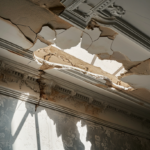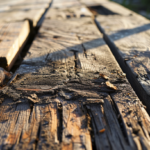Last Updated on 26th December 2023
In this article, we will explore effective techniques for repairing a leaking roof, providing step-by-step guidance to address this common issue faced by homeowners and property managers. By identifying the source of the leak, gathering necessary materials, and properly preparing the roof for repair, you can restore the integrity of your roof and prevent further damage. With our comprehensive approach, you will learn how to apply patching materials, repair damaged components, and seal the area to ensure a long-lasting and watertight solution.
Identifying the Source of the Leak
Regularly inspecting your roof is crucial in identifying the source of the leak and addressing the issue promptly. To identify common roof leaks, it is important to look for signs of roof damage. These signs may include missing or damaged shingles, cracked flashing, or clogged gutters. Inspect your attic for any signs of water stains or dampness, as this could indicate a roof leak. Additionally, pay attention to any water spots on your ceiling or walls, as these are clear indicators of a roof leak. It is also important to check for any signs of mold or mildew, as these can develop in areas where water has penetrated the roof. By identifying these common signs of roof damage, you can quickly locate the source of the leak and take appropriate action to repair it.
Gathering the Necessary Materials and Tools
Before beginning the repair process, it is crucial to gather all the necessary materials and tools. Essential repair materials include roofing cement, shingles, flashing, and nails, while must-have roofing tools consist of a ladder, hammer, utility knife, and a roofing nail gun. To ensure efficiency, make a detailed list of all required supplies and check them off as they are gathered.
Essential Repair Materials
When embarking on a roof repair project, it is crucial to have a comprehensive list of essential repair materials to ensure a smooth and efficient process. Repair techniques and preventing leaks require specific materials that are designed to withstand the elements and provide long-lasting protection. The first essential material is roofing cement, which is used to seal cracks and secure loose shingles or tiles. Flashing, another vital material, is installed around protrusions such as vents or chimneys to prevent water from penetrating the roof. Additionally, a high-quality underlayment is necessary to provide an extra layer of protection against moisture. Other essential materials include roofing nails, sealant, and roof coating to reinforce and enhance the durability of the repaired area. By having these essential materials on hand, homeowners can effectively address roof leaks and ensure the integrity of their roofs.
Must-Have Roofing Tools
To efficiently gather the necessary materials and tools for a roof repair project, it is essential to have a comprehensive list of must-have roofing tools, such as a roofing hammer and a roofing nail gun. These tools are essential for effectively fixing any roofing issues and ensuring the safety of the workers. Roofing safety should always be a top priority during any repair or maintenance project. It is important to wear protective gear such as gloves, goggles, and a hard hat to prevent any injuries. Additionally, regular roofing maintenance is crucial to prolonging the lifespan of the roof and preventing further damage. This includes regularly inspecting the roof for any signs of damage or leaks and promptly addressing any issues that arise. By having the necessary tools and prioritizing safety and maintenance, roof repairs can be completed efficiently and effectively.
Gathering Supplies Efficiently
In order to expedite the process of gathering supplies efficiently for a roof repair project, it is crucial to carefully plan and coordinate the procurement of necessary materials and tools, while also ensuring that they meet the required specifications. Efficient supply gathering involves identifying the exact materials needed, researching suppliers to find the best prices, and establishing a timeline for delivery. By streamlining the procurement process, project managers can save time and money, ultimately leading to a more cost-effective supplies procurement. It is important to consider factors such as quality, durability, and availability when selecting suppliers. Additionally, leveraging technology, such as online ordering and tracking systems, can further enhance the efficiency of supply gathering. By implementing these strategies, roof repair projects can be completed more smoothly and effectively, reducing downtime and maximizing overall productivity.
Preparing the Roof for Repair
Several steps must be taken to adequately prepare the roof for repair, including thoroughly inspecting the damaged areas and removing all debris. When it comes to roof repair, it is important to consider the cost and the option of hiring a professional. While some homeowners may choose to repair their roofs themselves to save money, hiring a professional can ensure the job is done correctly and efficiently. Professionals have the necessary knowledge and experience to identify and address any underlying issues, preventing further damage and potentially saving money in the long run. Additionally, professionals often have access to specialized equipment and materials, further ensuring a high-quality repair. When considering the cost of roof repair, it is important to factor in the potential risks and challenges involved in a DIY approach, which could lead to costly mistakes and the need for additional repairs.
Applying Patching Materials to Fix the Leak
When it comes to fixing a leak on your roof, applying the right patching materials is crucial. There are various options available, such as roof cement, roof sealant, or roofing tape, each with their own benefits and drawbacks. It is important to learn proper application techniques to ensure that the patching materials adhere correctly and effectively prevent any future leaks. Additionally, by using high-quality materials and following the proper techniques, you can ensure a long-term solution for leak prevention.
Patching Material Options
Regularly inspecting the roof and promptly addressing any leaks can help homeowners determine the most suitable patching material options for long-lasting repairs. When it comes to patching a leaky roof, there are several options available. One popular choice is roofing adhesive, which is a strong and durable material that can be applied to seal cracks and prevent further leaks. Roofing adhesive is a permanent solution that provides a long-lasting fix for leaks. However, in some cases, homeowners may need a temporary fix until they can arrange for a permanent repair. In these situations, temporary patching materials such as tarps or sealants can be used to provide an immediate stopgap measure. It is important to note that temporary fixes should be followed up with proper repairs to ensure the longevity of the roof.
Proper Application Techniques
To ensure a successful repair, it is essential to master the proper application techniques when using various patching materials to fix a leaking roof. The correct application techniques can make a significant difference in the effectiveness and longevity of the repair. One of the most common mistakes people make is not properly preparing the surface before applying the patching material. It is crucial to clean the area thoroughly and remove any debris or loose materials. Another common mistake is applying too much or too little patching material. It is important to follow the manufacturer’s instructions and apply the material evenly and in the recommended thickness. Additionally, it is important to allow sufficient time for the patching material to dry or cure before exposing it to harsh weather conditions. Mastering these application techniques will ensure a successful and long-lasting repair for a leaking roof.
Long-Term Leak Prevention
Applying an adequate amount of patching material and allowing it to fully dry before exposing the repaired area to harsh weather conditions is crucial for achieving long-term leak prevention. However, long-term leak prevention goes beyond just the initial repair. Regular long-term maintenance is necessary to ensure the continued integrity of the roof. This includes periodic inspections to identify any potential issues before they become major problems. Additionally, professional help should be sought for more complex repairs or if there is uncertainty about the extent of the damage. Professionals have the expertise and experience to assess the situation accurately and provide appropriate solutions. Neglecting long-term maintenance or attempting complex repairs without professional help can lead to further damage and costly repairs in the future. Therefore, it is essential to prioritize long-term leak prevention through proper maintenance and seeking professional assistance when needed.
Repairing Damaged Roofing Components
Inspecting the shingles for cracks and replacing them as necessary is crucial in the process of repairing damaged roofing components. Roof shingles are the first line of defense against water damage, and any cracks or missing pieces can lead to leaks and further structural issues. Additionally, fixing damaged flashing is also important in preventing water penetration. Flashing is a waterproof material that is installed around roof openings and joints to prevent water from seeping into the underlying layers. Over time, flashing can become damaged or deteriorated, compromising its effectiveness. By repairing damaged flashing, homeowners can ensure that their roofs are properly sealed and protected from water damage. Regular inspections and timely repairs are essential for maintaining the integrity of the roof and preventing costly and extensive repairs in the future.
Sealing and Waterproofing the Repaired Area
Furthermore, it is imperative to thoroughly seal and waterproof the repaired area to ensure long-lasting protection against water infiltration. When it comes to waterproofing techniques, there are several effective methods to consider. One popular technique is the use of sealants, which can be applied to the repaired area to create a watertight barrier. These sealants come in various forms, such as liquid coatings, tapes, and patches, allowing for flexibility in application. Additionally, another effective method is the installation of waterproof membranes. These membranes are typically made of synthetic materials and are applied over the repaired area to provide an extra layer of protection. It is important to choose the appropriate sealing method based on the specific needs and requirements of the repaired area. By implementing proper waterproofing techniques and sealing methods, the repaired area can be safeguarded against water infiltration, ensuring a long-lasting solution to the leaking roof.
Conducting a Post-Repair Inspection and Maintenance
How can we ensure the effectiveness and longevity of the roof repair by conducting a comprehensive post-repair inspection and maintenance? After completing a roof repair, it is crucial to conduct a thorough post-repair inspection to ensure the repair was successful and to identify any potential issues that may have been overlooked. A post-repair inspection checklist can help guide this process, ensuring that all necessary areas are inspected and evaluated. This checklist should include items such as checking for proper sealing, examining the integrity of the repaired area, inspecting adjacent areas for any signs of damage or leaks, and verifying that all repairs were completed as specified. Additionally, routine roof maintenance should be implemented to prolong the life of the repair. This includes regular inspections, cleaning debris, checking for any signs of damage or wear, and addressing any issues promptly to prevent further damage or leaks. By conducting a comprehensive post-repair inspection and implementing routine maintenance, we can ensure the effectiveness and longevity of the roof repair.




